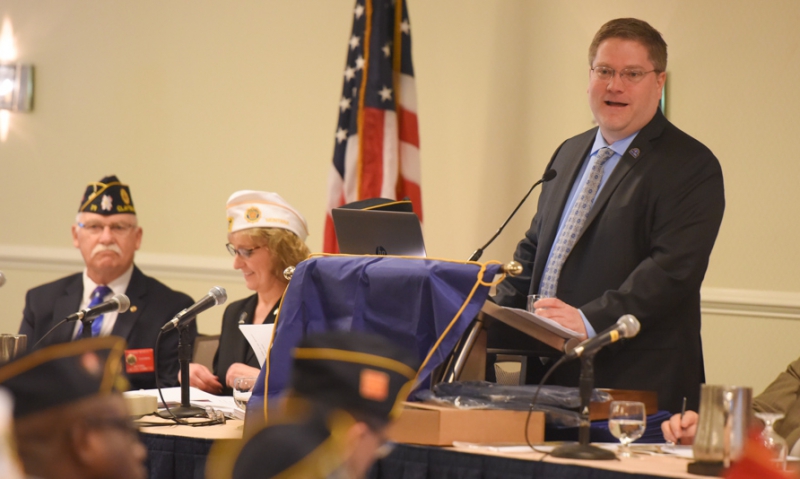
VA: Trust being regained, but work remains
The Department of Veterans Affairs is improving, the executive in charge of the department’s Information and Technology told The American Legion’s Veterans Affairs & Rehabilitation Division on Feb. 26.
But despite improvements, Scott Blackburn told Washington Conference attendees that work remains to continue to restore confidence in the health-care system.
“When I joined the VA in 2014 … we were all on a journey together to regain the trust of veterans,” Blackburn said. “Trust was obviously broken in 2014. We started measuring that trust in 2015. In December 2015, we asked veterans whether or not they trusted VA to fulfill our nation’s commitment to veterans. And only 47 percent did.
“You’ve seen a steady climb. We’re now up around 69, 70 percent of veterans’ trust that we’ve re-earned, but still nowhere near where we need to be. We still have an awful lot of work to do.”
Blackburn said that transparency is an issue, noting that a magazine a few years ago named VA the government’s most secretive agency. “That is not the list we’re looking to top,” he said. “We’re actually looking to be quite the opposite. We’re trying to become the most transparent organization. We still have a little bit of ways to go.”
Switching to technology, Blackburn said his primary goal is working on VA’s electronic health record. “Today we don’t have one outdated electronic health record. We have 130 that don’t necessarily talk to each other,” he said. “The vision here is to have one single, meaningful health record for veterans. We need to have a better system. We need to … have the technology in place that allows that information to happen. We’re working … to make that a reality.”
That system will have four levels of interoperability, Blackburn said: interoperability with VA, interoperability between VA and the Department of Defense (DoD), interoperability between VA/DoD affiliates and community providers, and national interoperability.
Carolyn Clancy, executive in charge for the Veterans Health Administration, said while VA strives to improve wait times and compares favorably in most locations with the private sector, “We know that we’ve got to have same-day services … for urgent issues of primary care and mental health. And as of this past November, not only is it the major medical facilities – it’s every last (community-based outpatient clinic) as well.
“Now same day doesn’t necessarily mean a visit. It might be a telephone call, an email or just fixing their problem. That is really a big deal, and we can see we're making a lot of progress.”
More and more veterans are choosing VA, Clancy said, to the tune of 48 percent of the veteran population in 2016. “The word is out among veterans that things are getting better,” she said. “We know that veterans are more likely to use their benefits, including health care, than even a few years ago.
“We think that is great news. It creates challenges for us, but we’re thrilled to have those challenges and opportunities. We want every veteran who is eligible to choose VA.”
Thomas Murphy, executive in charge for the Veterans Benefits Administration, provided an update on both the Decision Ready Claims (DRC) and Rapid Appeals Modernization Program (RAMP) initiatives. Murphy said that 664 DRC claims have been submitted in four months, with 629 having been adjudicated. He said the program is designed to provide veterans with a decision within 30 days from the time VA receives the claim.
RAMP was designed to make the appeals process more transparent, flexible and efficient, in order for veterans to receive fairer and quicker decisions. “Those (veterans) that are opting in are getting their appeal they’ve been waiting on for years, they’re getting a rating decision in as little as 35 days,” Murphy said. “It’s going fast, and it’s resolved in favor of the veterans many times.”
Murphy said that as of Feb. 1, 2018, 50,000 letters have been sent out to veterans to inform them of their eligibility for RAMP. More than 15 percent of those are represented by American Legion service officers.
Melody Libby of AbbVie told the commission that while 65,000 veterans have been treated for Hepatitis C (HVC), at least 700,000 potential sufferers have not even been screened. As veterans have a higher rate of HCV, she urged going to a VA facility for a specific HCV blood test.
